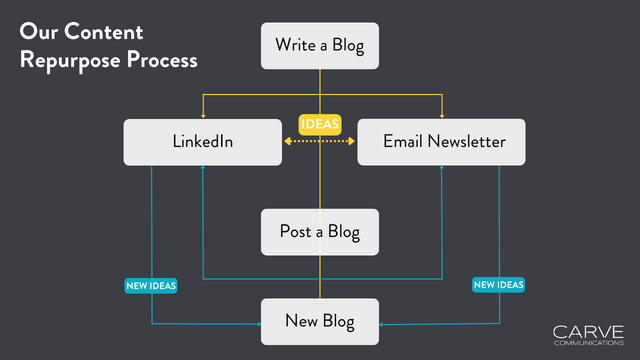We Analyzed the Changes to Our 2022 Content Strategy. Here’s What We Learned.
Published April 28, 2022
I always thought being a writer meant that I didn’t have to look at numbers all day. As an English major and lover of books, that was a selling point of the job.
But only liars will tell you data and storytelling are mutually exclusive.
Data helps point out which stories are most compelling to your audience and the ones that will help achieve your goals. Most importantly, data will ensure people read the stories you write.
Removing data analysis from your content strategy is like wearing a blindfold while driving — how do you understand where you’ve been, where you are, and where you are going?
In 2021, we launched a dedicated content team at Carve (serving clients and our agency). One of the first things we did for our agency efforts was to gather and analyze data from what had already been done in-house so that we could begin learning, experimenting, and eventually improving content. That led to the strategy we execute today across our blog, LinkedIn feed, and monthly newsletter.
Over 2022, we changed a lot and learned even more. Now, we are sharing our learnings with you.
Lessons We Learned About Improving Content in 2022
Prioritize Editorial SEO: Write First, Optimize Later.
When we first established our content strategy, one of our first priorities was Search Engine Optimization (SEO) of all new blog posts (alt-tags, headers, metadata… the whole enchilada). Our organic search traffic was lagging behind and, despite the consistent creation of blogs, places like the Homepage drove the most entrances to our website.
But we didn’t want to trade our unique storytelling and brand voice just to hit numbers. So, we identified opportunities and wrote content as we normally did: listening to clients, potential clients, and team members. We came up with ideas around successful SME interviews and successful pitching for holiday gift guide coverage.
Then, we wrote those ideas and optimized only after that was done. We call this “editorial SEO.” While technical and programmatic SEO both focus more on a formulaic approach to keywords and content, editorial SEO is content-first and relies more on search intent than technical aspects to rank.
We recognize SEO as the means to identify opportunity — not the opportunity itself.
Data can give you a good indication of topics people are interested in and looking for, but what happens next depends on how well you know your target audience and your craft. When you let SEO dictate what and how you write, it can water down value for a reader. Let’s face it, we’ve all seen keyword-stuffed content with awkwardly placed words and phrases.
Prior to 2022, direct traffic was our bread and butter, bringing in more than 50% of all traffic. But because we invested in an editorial SEO and content-first approach, we saw organic search traffic more than double, pageviews on blog posts increase by 415%, and blogs become top entrance drivers to our website.
Lean Into Obvious Audience Interest Topics.
When something resonates with your audience and becomes a top traffic and interest driver, what do you do?
Lean into it.
Figure out why it’s working and how you can create something similar but not the same. Or, as they say in PR, find a new angle. Our “Reporters to Know” blog, focusing on Miami Tech journalists, consistently showed up as one of the top three blogs by pageviews and organic search every quarter.
So, halfway through the year, we launched an original series inspired by the data: introducing our readers to top journalists across different industries. We re-optimized “Reporters to Know” into “Miami Tech Reporters to Know”, spinning off many other blogs like “Consumer Tech Reporters to Know”, “Venture Capital Reporters to Know”, and so on.
We see these consistently hit top spots on our blog and website traffic and as strong performers on LinkedIn (views) and on our monthly newsletter (clicks). At the same time, it achieves our goal of communicating that potential clients are in good hands with us.
Take hints from your data. It will lead you to the content your audience is most interested in and then you can capitalize on that to diversify your strategy.
Create a Living, Breathing Content Marketing Ecosystem
As a writer, there is little more frustrating than spending time researching, writing, and editing content only to send it out into the great void and move on to the next project. Or worse, you look at the numbers and see only a handful of prospects read it.
A simple way to tank your content strategy is to treat each channel as its own separate entity. You want to create a content marketing ecosystem. Email, social media, and blog should be connected — what you publish on the blog should be distributed to social media and newsletter audiences.
While our Time to Hire a Ghostwriter blog post performed average on LinkedIn, newsletter subscribers ate it up.
Conversely, our “How I Got Here” culture blog posts don’t earn huge organic traffic numbers, but they do work on LinkedIn. They’re often the most popular LinkedIn posts, ranking in the top 5 posts for driving users to our website every quarter.
Then, you have the hits. For us, that was our 2022 La Casa Comic, a creative piece that skyrocketed our website traffic. When we tailored it to our different channels – an email send to those involved in the event, our monthly newsletter email, social media, and a dedicated blog post to the behind-the-scenes work – it earned record-high levels of engagement and website traffic.
This is what our December analytics looked like:
But, to experience hits like this, you have to give content a chance to be discovered by treating your content like an ecosystem, versus individual channels.
Know When to Create New Content Versus Using a Content Repurposing Workflow
Part of creating a content marketing ecosystem means ensuring everything successful idea within your current content fulfills its highest potential — never one-and-done.
As Mark Twain put it, everything is recycled.
“There is no such thing as a new idea. It is impossible. We simply take a lot of old ideas and put them into a sort of mental kaleidoscope. We give them a turn and they make new and curious combinations. We keep on turning and making new combinations indefinitely, but they are the same old pieces of colored glass that have been in use through all the ages.”
If a piece performs well on social media, consider another channel audience it might resonate with. If that piece is a blog, take a moment and note all the ideas and examples that could work well on social media or in a newsletter. With a little editing and finessing, three blogs together might equate to an eBook.
For example, we pull facts, stats, and interesting anecdotes from popular blogs for our LinkedIn feed. We also use thoughts from the editorial section of successful newsletters in blog posts and vice-versa.
Here’s an example of a LinkedIn post and the creative inspiration section of our newsletter in May 2022. Look familiar?
REPURPOSE. REPURPOSE. REPURPOSE.
When the data shows you a piece resonating with your audience, do some digging into the content and find out why. Then, figure out the right channel and how to make improve it slightly to re-purpose those ideas and parts.
Your content repurposing workflow should look something like this:
Yes, you need to produce new and unique content. But when you do, make sure every idea in that piece of content is being used somewhere else in your holistic strategy.
No content strategy out there is completely perfect and finished — that’s the beauty of it. When the data changes, so does your strategy. Our 2022 learnings will help us in developing our editorial plans and improving content in 2023 and beyond.






